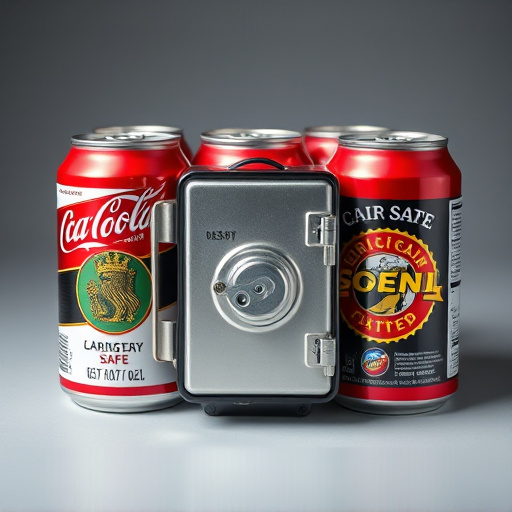In today's world, everyday household items like bags, wallets, and even furniture are secretly transforming into versatile safes through integrated hidden compartments. Leveraging modern engineering, these innovative products offer both functionality and discretion for secure storage of valuable items like important documents, precious metals, or personal devices. By modifying books, retro radios, or kitchen utensils, users can create hidden safes that blend seamlessly into their surroundings, providing enhanced security and peace of mind. However, this trend sparks ethical debates and calls for proactive guidelines to protect privacy and data security as technology advances.
Hidden compartments within everyday household items have emerged as a revolutionary concept, transforming ordinary products into secret safes. This innovative approach to security allows users to conceal valuable items or sensitive documents in seemingly innocuous objects like books, pens, or even kitchen utensils. The article explores this intriguing phenomenon, delving into its benefits for privacy and safety while also considering ethical implications and future directions.
- Understanding Hidden Compartments: Unveiling the Concept
- Everyday Items as Secret Safes: A Creative Approach to Security
- Benefits of Concealed Compartments in Consumer Products
- Ethical Considerations and Future Implications
Understanding Hidden Compartments: Unveiling the Concept
In the world of everyday household items, it’s fascinating to uncover the hidden potential for secret compartments. These concealed spaces within seemingly ordinary objects have long been a staple in spy novels and movies, but they’re becoming an intriguing reality for consumers looking to keep their belongings secure and private. By integrating this technology into everyday products, innovative designers are transforming common items like bags, wallets, and even furniture into versatile safes.
The concept of hidden compartments is not new, but modern engineering and materials have elevated their effectiveness and discretion. From cleverly designed bookshelves that double as secret stashes to stylish briefcases with hidden locks, these products offer a fresh approach to security. The appeal lies in the blend of functionality and surprise—everyday household items that serve dual purposes, ensuring peace of mind while offering a unique and often subtle way to store valuable items, keeping them out of sight and reach of prying eyes.
Everyday Items as Secret Safes: A Creative Approach to Security
In today’s world, security is a top priority for many individuals, yet traditional safes and hidden spots might not always be accessible or practical. This is where everyday household items can step in as innovative secret compartments, offering a creative approach to safeguarding valuables. From an ordinary-looking book to a retro radio, these seemingly innocuous objects can conceal valuable items, ensuring they remain out of sight and reach.
By utilizing the right everyday items with clever modifications, one can create hidden safes that blend seamlessly into their environment. This method not only adds an extra layer of security but also allows for a more discreet way to store sensitive materials, such as important documents, precious metals, or even personal devices. The beauty lies in the fact that these secret compartments are often right under our noses, making them an excellent solution for those seeking a unique and stealthy means of protection.
Benefits of Concealed Compartments in Consumer Products
In today’s world, where privacy and security are paramount, concealed compartments in everyday household items offer a unique solution for keeping sensitive materials out of sight and reach. These secret compartments provide an added layer of protection, allowing individuals to store valuable items, personal documents, or even emergency supplies discreetly within seemingly ordinary products. From hidden safes built into books to cleverly designed compartments within kitchen utensils, this innovative approach leverages everyday household items as a means for secure storage.
The benefits of concealed compartments are multifaceted. They enhance security by offering clandestine storage spaces that deter unauthorized access. Moreover, they promote peace of mind, ensuring that important possessions remain safe and secure. This is particularly valuable for individuals who travel frequently or have concerns about home security. By integrating these features into everyday items, consumers can transform ordinary household products into versatile tools that seamlessly blend functionality with discretion.
Ethical Considerations and Future Implications
The concept of hidden compartments within everyday household items has sparked both fascination and ethical debates. While the idea of integrating secret compartments into consumer products offers unique advantages, such as enhanced security and creative problem-solving, there are significant moral considerations to address. Concealing spaces for valuable items or sensitive information inside common objects like books, candles, or even kitchen utensils raises privacy concerns and could facilitate illegal activities if exploited.
Looking ahead, the development of secret compartments in consumer products may have profound implications for personal security and privacy. As technology advances, the potential for more sophisticated hiding places integrated into everyday items is ever-growing. This evolution necessitates a proactive approach to ethical guidelines and regulations. Future consumers must be protected from unintended consequences while still enjoying innovative product designs that cater to their needs, especially in an era where data privacy and secure storage of personal belongings are paramount.
Hidden compartments within everyday household items offer a unique and creative solution for enhancing security. By integrating secret compartments into consumer products, individuals can safeguard valuable items or sensitive information while maintaining an unassuming exterior. This innovative approach leverages the familiarity of common objects to provide discreet storage, making it an attractive option for personal safety and privacy. As the concept gains traction, ethical considerations and future implications should be carefully navigated to ensure responsible adoption and widespread benefits.
